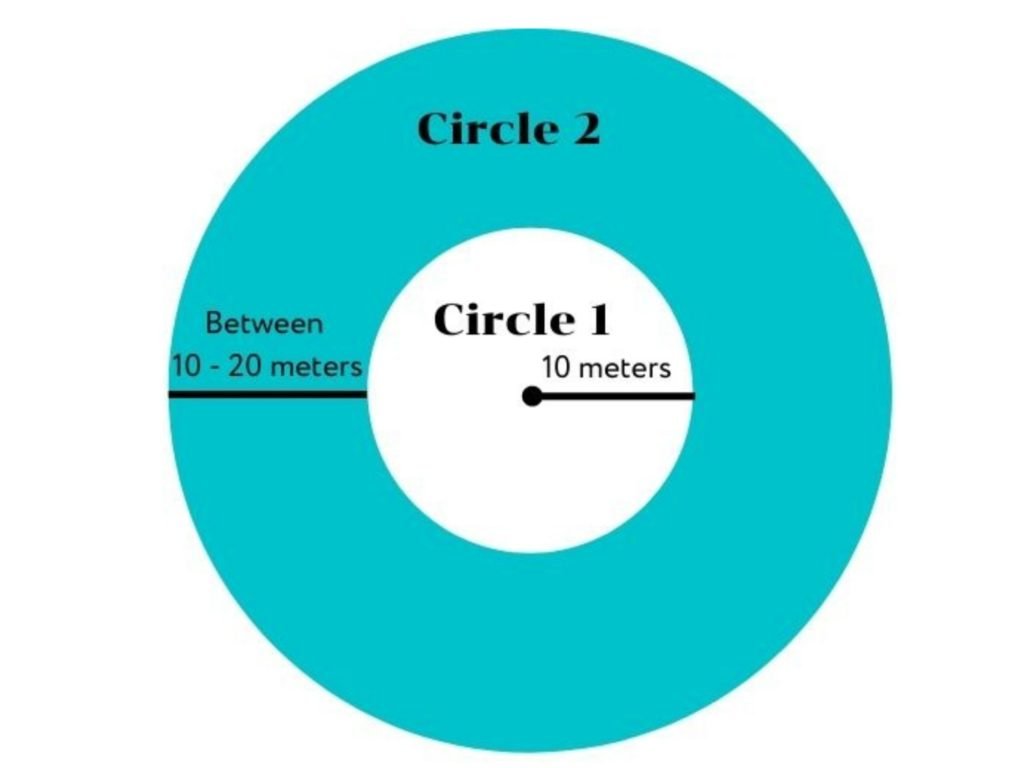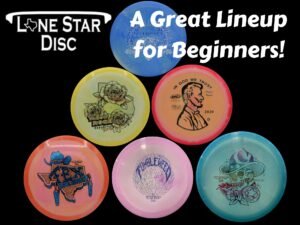
After listening to my favorite disc golf podcast Disc Golf Answer Man (DGAM), I ended up watching John E McCray on the recommendation of Eric Oakley. He wants us to look at McCray’s pronounced follow-through and emulate that. I don’t think I’m quite there yet, but I watched regardless (I’m hooked to the sport). On the first hole, at the 2:15 mark of this video, McCray is confirming that he is, in fact, outside of circle 1. He looked relieved to find out that he was.
It seemed a little odd to me. Was McCray just hoping to bolster his circle 2 stats or something? Shortly after, the announcers explained that McCray was probably confirming so that he could do his step putt.
Sure enough he was outside circle 1 (in circle 2), and sure enough he did his step putt. And, just so I don’t leave you hanging, it was nails.
This, of course, triggered a series of questions for me. What are the circles in disc golf? What are the rules for each circle? How much more effective is a step putt or jump putt? When should I use them?
And on and on my brain goes… But for here and now, let’s look into the disc golf putting circles and the various rules within each. Then, we’ll look into the effectiveness of jump/step putting and see whether or not I should look into practicing these so early on in my development (9 weeks).
disc golf’s Circle 1 and circle 2 explained

Picture the pole of the basket as the center of the circle. Now mentally tie a string to the base of the pole. Stretch the string out straight from the pole and mark the string at 10 meters from the pole. Now, using the string, walk in a circle around the pole spray painting the grass in that 10 meter(32.8 feet) circle .
That circle you made is circle 1.
Another way to say it is that circle 1 has a radius of 10 meters (32.8 feet) “from the base of the target” (as written in the rules).
For Circle 2, now stretch that string out to 20 meters (65.6 feet). In your mind spray paint a circle around the basket 20 meters from the basket. This is the edge of circle 2.
Any shots made between 10 and 20 meters from the basket are in circle 2.
So what is the significance of these circles? Let’s look.
The Significance of Circles 1 and 2
Basically, based on what I see in the rules, circle 1 is definitely the most important to understand for tournament play. If you don’t understand the rules of circle 1 then you could find yourself getting penalized.
In fact, now that I’ve read some of the rules I’m quite sure I’ve done some things incorrectly in the past…

For circle 1 putting you have to establish balance and control after you release the putt. Then, once established, you can start walking to the basket to get your disc.
In other words, you CANNOT lean towards the basket and have your momentum tip you forward into a stride towards the basket (I’m almost positive I’ve done this).
You have to release, pause, watch, wait, and then go get your disc.
If you fail to establish this control/balance it could result in a 1-stroke penalty. I don’t know about you, but I cannot afford to lose any more strokes in disc golf. I need every one of them!
Here’s the official rule verbatim (found at pdga.com): “After having released a putt, the player must demonstrate full control of balance behind the marker disc before advancing toward the target. A player who fails to do so has committed a stance violation and receives one penalty throw.“
Circle 2, from what I see, doesn’t matter nearly as much. You can step-putt, jump-putt, or throw normally. From what I gather, circle 2 is more of a way to compare players using statistics. “Player X is hitting 43.8% of their shots within circle 2,” type of thing.
You can then use that to compare Player X to Player Y, for example.
And while we’re here, let’s clarify one more question I had…
What Happens if your Disc Lands on the Line of Circle 1?
Here’s where it gets a little sticky folks! If your disc is half in and half out you have options! If you choose to mark your disc you are in circle one and closer, but subject to the rules of circle 1.
However, because your disc is partly in circle 2, you can opt to leave your disc where it is, putt from behind it, and enjoy the rules of circle 2 putting. Check out this video (at 37:08) as Calvin Heimburg explains this to Simon Lizotte in order to determine whether or not Drew Gibson is in circle 1 or 2.
It is later explained that Drew’s lie is either the back edge of the mini-marker (if he opts to put it down) or the back of the disc, if he opts to leave it where it is.
In the end, if the lie you choose is 10 meters or less from the pole, then you are in circle 1. That means you must follow the circle 1 putting rules. This really comes into play if you feel the longer distance is worth it because your jump/step putting gives you an advantage.
For my purposes, as a beginner, I’ve got more pressing things to concern myself with, than whether or not I’m exactly at the edge or not. I’ve never done a tournament, but I’m assuming that you can get clarification or you just ask your fellow players to make a judgement (like in the video). If any of you have experience with this, please feel free to put it in the comments below.
For me, they’d probably correctly assess that I’m not a threat and say “Do what you want dude.”
If I’m ever practicing and I want to get a quick feel, then pacing off 11 paces (3 feet per step) should get me to about the 33 foot mark. That rough estimate should be more than adequate for unofficial play.
That’s what I plan to use moving forward. For now, not knowing how to jump-putt or step-putt, it’s mostly a moot point. Still, I’m wondering if it is worth my while to invest time into these forms of putting…
Learning to Step-Putt or jump-Putt
Until now, I’ve mostly been learning to putt within 25 feet.
Now, I’m investing my time into learning the step-putt for longer range putts. I’ve curated some of the best guides that have helped me tremendously and put them together in a post called The Disc Golf Step Putt: A Complete Guide!
My logic is simple. If John E McCray was hoping that he was in circle 2 so that he could step putt, then step-putting must have value. And if Drew Henson chose to be farther away, the same logic applies. Right now I’m horrendous from anywhere close to Circle 2, so it couldn’t get worse I suppose…
My fear is that it will compromise my stationary putting technique and promote bad habits. If any of you have thoughts on the matter, then I am all ears. Will I be able to separate my regular putting from these distance putts so that one doesn’t affect the other? Let me know in the comments below (along with anything else loosely related to this post).
As it stands now, I think I will invest some small amounts of time into these putts, but mostly I plan to continue practicing my regular putting and my throwing accuracy (which needs A LOT of work).
Disc Golf Putting Circles In Summary
There are 2 putting circles in this disc golf world of ours, circle 1 and circle 2. (Note: I’ve heard mention of “circle 3” on a broadcast or two, but I think it’s just so the pros can feel superior to us mere mortals. Nevertheless, I’m guessing it would be from 20 – 30 meters.)
Circle one is measured as 10 meters (32.8 feet or about 11 paces) from the pole of the basket. Circle 2, extends from the 10 meter mark out to the 20 meter mark and is usually used to compare statistics between players much better than me.

Circle 1 is where the opportunity for penalty strokes can occur. This is where it is good to know that you must establish balance/control before going to retrieve your putt. You cannot fall forward towards the basket and just keep walking. That is a penalty and we don’t need any extra strokes added to our scores…
Finally, I plan to dabble with jump/step-putting. It is clearly valuable to the pros and I doubt I could get too much worse. I will be sure to let you know my findings in due time!
In the meantime, keep disc golf’n around the putting circles and enjoy the ride!
Thanks for reading everyone. If you have ideas/answers/questions that you want to share, feel free to post them below. I truly enjoy looking into all sorts of things so let me know what’s on your mind and I’ll deep dive it for you. Also, as I write, this is a very new website. If you find any of it valuable don’t be afraid to share it and/or subscribe. Then you can tell people you found it first! Until next time, keep disc golf’n around everyone!
Check Out These Other Posts!
- Lone Star Disc Has a Great Lineup for Beginners!

- The MVP Trail Disc – Should you Get it?

- The 3 Best Disc Golf Bags with Coolers For Any Budget!

- Best Disc Golf Misprints for Your Bag!

- Top 5 Fun Disc Golf Mystery Boxes!

- Top 5 Backpack Disc Golf Bags for 2025!

- 5 Best Disc Golf Cart Accessories!

- The Best Disc Golf Putter Pouch For Your Cart!

- Top Disc Golf Basket Lights For Night!


Comments are closed.